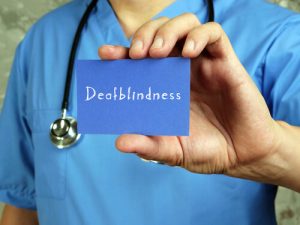In a world where communication serves as the cornerstone of human connection, the challenges faced by individuals with deafblindness deserve our utmost attention. Deafblind communication, an intricate and multifaceted process, bridges the sensory divide and enables these remarkable individuals to forge meaningful connections with the world around them. With both auditory and visual impairments, navigating this unique realm requires innovative approaches and a deep understanding of the deafblind experience.
In this article, we delve into the fascinating realm of speech and deafblind communication, unraveling its complexities and exploring the techniques that empower deafblind individuals to express themselves and engage with society.
Exploring the Basics of Deafblind Communication

Deafblind’s communication system encompasses diverse strategies and tools, uniquely tailored to individuals with dual sensory impairments. This form of communication adapts to the specific needs, preferences, and residual sensory capabilities of each deafblind individual, incorporating various methods, from sign language adaptations to technological aids.
- Diverse Communication Strategies: Strategies vary based on individual residual hearing, vision, and personal preferences, ensuring a personalized approach.
- Sign Language Adaptations: American Sign Language (ASL) and British Sign Language (BSL) are adapted for tactile or visual use, forming a core communication method.
- Tactile Methods: Tactile sign language and fingerspelling are crucial for those with minimal or no usable vision, allowing communication through touch.
- Technological Aids: Devices like hearing aids, braille displays, and adapted computer screens provide auditory or tactile access to information.
- Understanding Non-Verbal Cues: For individuals with significant vision and hearing loss, vibrations and movements on the other person’s cheek or chin help understand facial expressions and mood.
Techniques and Tools for Effective Communication with Deafblind Individuals
Effective communication with deafblind individuals requires a multifaceted approach, integrating various techniques and tools to accommodate dual sensory impairments. This communication with deafblind communicate is crucial for their social inclusion and access to information, relying on a blend of specialized methods and adaptive technologies.
Tactile Sign Language:
A cornerstone technique for those with little to no usable vision, tactile sign language involves the deafblind individual feeling the signs through touch, either on the signer’s hand or through tactile fingerspelling.
Braille and Raised Dots:
Braille remains a vital tool, allowing individuals to read through touch. Raised dots can also convey information in a tactile format, which is especially useful for those with vision and hearing loss.
Hearing Aids and Assistive Listening Devices:
For those with residual hearing, hearing aids can amplify sounds, while assistive listening devices can filter background noise, enhancing communication efficiency.
Facial Expressions and Physical Contact:
Physical contact, like touching the other person’s cheek or hand, can be effective for conveying emotions and nuances. This method allows the deafblind person to feel vibrations and movements that indicate mood or reaction.
Specialized Communication Systems:
Various communication systems, such as the deafblind manual alphabet or an English-based tactile system, provide customized communication methods, accommodating individual preferences and backgrounds.
Adaptive Technology:
Technology plays a crucial role, with tools like adapted computer screens and communication devices designed specifically for the deafblind community enabling them to access digital information and communicate electronically.
The Role of Technology in Enhancing Deafblind Communication

The integration of technology in enhancing communication for deafblind individuals marks a significant leap forward in addressing their unique needs. By leveraging innovative tools and devices, technology bridges the sensory gap, facilitating more effective and independent communication for blind people and those with dual sensory impairments.
- Adaptive Devices for Improved Hearing: Hearing aids and advanced hearing technologies are crucial for those with residual hearing. These devices can amplify sound, filter background noise, and connect wirelessly to other gadgets, enhancing auditory input for effective communication.
- Braille Technology: Braille displays and writers, which convert digital text into tactile Braille, provide an invaluable tool for accessing information. These devices enable deafblind individuals to read electronic texts, including emails and digital books, through touch.
- Tactile Communication Devices: Tactile communication devices, such as those using raised dots or vibrations, transmit information in a tactile format, thus enabling deafblind individuals to receive messages and alerts.
- Screen Reading Software: For those with some usable vision, screen reading software and magnification tools help access content on computer screens, smartphones, and other digital devices, adjusting the visual display to individual visual needs.
- Mobile Applications: Various mobile applications are designed specifically for the deafblind, offering features like voice-to-text, text-to-braille, and customized user interfaces, enhancing communication and accessibility.
- Vibratory Feedback Systems: These systems convert auditory signals into vibratory ones, allowing deafblind individuals to perceive sounds through touch, facilitating an understanding of their environment and enhancing interaction.
Understanding the Challenges and Solutions in Deafblind Communication
Communicating with deafblind individuals presents unique challenges stemming from the dual loss of sight and hearing. These challenges require innovative solutions to facilitate effective communication and ensure deafblind individuals can interact meaningfully with their environment and community.
- Challenge of Limited Sensory Input: The primary challenge in deafblind communication is the reduced or complete lack of visual and auditory inputs. This necessitates the development of alternative communication methods, such as tactile sign language, to convey messages effectively.
- Adapting Communication Methods: Solutions like tactile fingerspelling, Braille, and the deafblind manual alphabet have been developed to bridge the communication gap. These methods allow for the transmission of complex information through touch.
- Technological Barriers: The rapidly evolving nature of technology can be both a boon and a barrier. While assistive technologies like hearing aids and adapted computer screens are invaluable, ensuring that these technologies are accessible and user-friendly for deafblind individuals remains challenging.
- Social Isolation and Misunderstanding: Deafblind individuals often face social isolation due to communication barriers. The solution lies in educating the public and developing community programs that foster inclusivity and understanding.
- Personalized Communication Strategies: Every deafblind individual has unique needs and preferences. Developing personalized communication strategies, considering factors like residual hearing or vision, is crucial. This may involve combining various communication methods and technologies.
- Training and Education: Providing adequate training in specialized communication techniques for interpreters, caregivers, and educators is vital. This ensures that deafblind individuals receive the support they need to communicate effectively.
In conclusion, effective deafblind communication is crucial for individuals with combined vision and hearing loss to lead independent and fulfilling lives. By utilizing various techniques such as tactile sign language, Braille, and assistive technology, deafblind individuals can overcome communication barriers and connect with the world around them. Society must continue raising awareness and implementing inclusive strategies to support deafblind individuals daily. By prioritizing accessible communication and fostering a more inclusive environment for the deaf community, we can empower deafblind individuals to thrive and participate fully in all aspects of society.
References
Communication
https://deafblind.org.uk/get_support/communication/
Deafblind Manual
https://www.sense.org.uk/information-and-advice/communication/deafblind-manual/
Overview of Communication Methods
https://www.nationaldb.org/info-center/educational-practices/overview-communication-methods/
The evolution of deafblind communication
https://www.perkins.org/the-evolution-of-deafblind-communication/
Deafblind Communication qualifications – Level 2 to Level 3
https://www.signature.org.uk/deafblind-communication/


